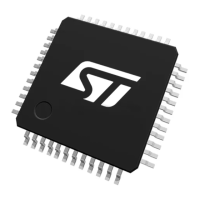RM0444 Rev 5 497/1390
RM0444 AES hardware accelerator (AES)
522
Suspend/resume operations in GCM mode
20.4.11 AES Galois message authentication code (GMAC)
Overview
The Galois message authentication code (GMAC) allows the authentication of a plaintext,
generating the corresponding tag information (also known as message authentication
code). It is based on GCM algorithm, as defined in NIST Special Publication 800-38D,
Recommendation for Block Cipher Modes of Operation - Galois/Counter Mode (GCM) and
GMAC.
To suspend the processing of a message, proceed as follows:
1. If DMA is used, stop the AES DMA transfers to the IN FIFO by clearing the DMAINEN
bit of the AES_CR register. If DMA is not used, make sure that the current computation
is completed, which is indicated by the CCF flag of the AES_SR register set to 1.
2. In the payload phase, if DMA is not used, read four times the AES_DOUTR register to
save the last-processed block. If DMA is used, wait until the CCF flag is set in the
AES_SR register then stop the DMA transfers from the OUT FIFO by clearing the
DMAOUTEN bit of the AES_CR register.
3. Clear the CCF flag of the AES_SR register, by setting the CCFC bit of the AES_CR
register.
4. Save the AES_SUSPxR registers in the memory, where x is from 0 to 7.
5. In the payload phase, save the AES_IVRx registers as, during the data processing,
they changed from their initial values. In the header phase, this step is not required.
6. Disable the AES peripheral, by clearing the EN bit of the AES_CR register.
7. Save the current AES configuration in the memory, excluding the initialization vector
registers AES_IVRx. Key registers do not need to be saved as the original key value is
known by the application.
8. If DMA is used, save the DMA controller status (pointers for IN data transfers, number
of remaining bytes, and so on). In the payload phase, pointers for OUT data transfers
must also be saved.
To resume the processing of a message, proceed as follows:
1. If DMA is used, configure the DMA controller in order to complete the rest of the FIFO
IN transfers. In the payload phase, the rest of the FIFO OUT transfers must also be
configured in the DMA controller.
2. Ensure that the AES peripheral is disabled (the EN bit of the AES_CR register must be
0).
3. Write the suspend register values, previously saved in the memory, back into their
corresponding AES_SUSPxR registers, where x is from 0 to 7.
4. In the payload phase, write the initialization vector register values, previously saved in
the memory, back into their corresponding AES_IVRx registers. In the header phase,
write initial setting values back into the AES_IVRx registers.
5. Restore the initial setting values in the AES_CR and AES_KEYRx registers.
6. Enable the AES peripheral by setting the EN bit of the AES_CR register.
If DMA is used, enable AES DMA requests by setting the DMAINEN bit (and DMAOUTEN
bit if in payload phase) of the AES_CR register.

